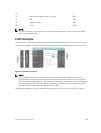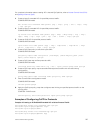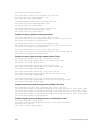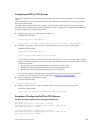
19 — 1
20 Source miss, Station move, Trace flow 600
21 BFD 7000
22 HyperPull, FRRP 800
23 sFlow 5000
NOTE:
In the line-card CPU, some queues have no protocol traffic mapped to them. These rows appear
blank in the preceding table.
CoPP Example
The illustrations in this section show the benefit of using CoPP compared to not using CoPP on a switch.
The following illustration shows how CoPP rate limits protocol traffic destined to the control-plane CPU.
Figure 24. Control Plane Policing
NOTE:
On the Z9500, CoPP does not convert the input rate of control-plane traffic from kilobits per
second (kbps) to packets per second (pps) as on other Dell Networking switches. On other switch,
CoPP converts the input kilobit-per-second rate to a packet-per-second rate, assuming 64 bytes as
the average packet size. CoPP then applies the packet-per-second rate to the appropriate queue.
On these switches, 1 kbps is approximately equal to 2 pps.
The following illustration shows the difference between using CoPP and not using CoPP on a switch.
Control Plane Policing (CoPP)
225


















